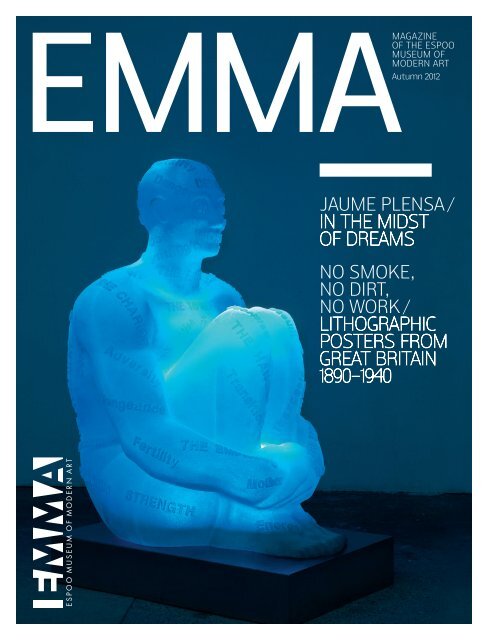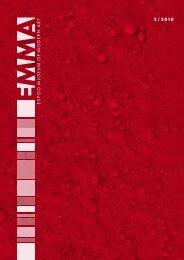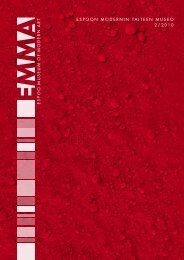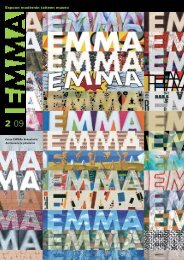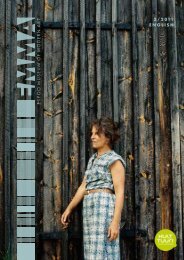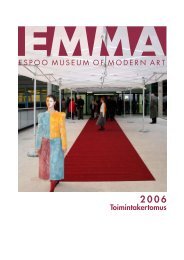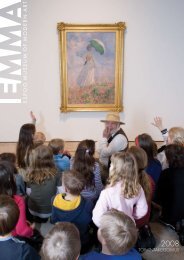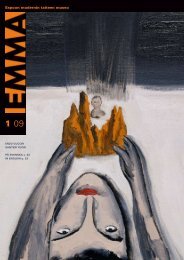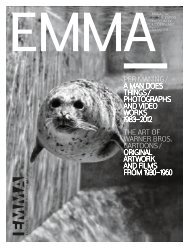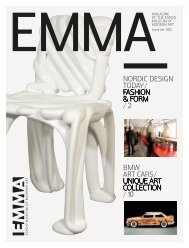EMMA Magazine (pdf)
EMMA Magazine (pdf)
EMMA Magazine (pdf)
Create successful ePaper yourself
Turn your PDF publications into a flip-book with our unique Google optimized e-Paper software.
MAGAZINE<br />
OF THE ESPOO<br />
MUSEUM OF<br />
MODERN ART<br />
Autumn 2012
2 <strong>EMMA</strong><br />
Exhibitions + Contents<br />
3 EDITORIAL<br />
What does a museum<br />
look like?<br />
JAUME PLENSA La Llarga Nit, 2010. Jonty Wilde © Yorkshire Sculpture Park, UK. BRITTISH POSTER © The State Pushkin Museum of Fine Arts, Moscow.<br />
PER MANING Oscar, 1988. BUGS BUNNY Copyright © Warner Bros., Inc.<br />
Jaume Plensa /<br />
In the Midst of Dreams /<br />
14.11.2012–27.1.2013<br />
The World in a Suitcase /<br />
Juhani Harri’s Assemblages /<br />
11.11.2011-17.3.2013<br />
Per Maning /<br />
6.3.-9.6.2013<br />
No Smoke, No Dirt, No Work /<br />
Lithographic Posters from<br />
Great Britain 1890–1940 /<br />
14.11.2012–27.1.2013<br />
The Saastamoinen Foundation<br />
Art Collection /<br />
Permanently<br />
Bugs Bunny And Friends /<br />
Animation Drawings from<br />
The Warner Bros. Studios<br />
1930–1960 / 6.3.–5.5.2013<br />
4 JAUME PLENSA<br />
Sculptor of light<br />
and images<br />
6 WORKS FROM<br />
THE SAASTAMOINEN<br />
FOUNDATION<br />
ART COLLECTION<br />
7 PUBLIC ART FROM<br />
<strong>EMMA</strong>’S COLLECTIONS<br />
8 NO SMOKE,<br />
NO DIRT, NO WORK<br />
Lithographic posters<br />
from Great Britain<br />
1890–1940<br />
10 EXHIBITIONS<br />
& CALENDAR<br />
11 UPCOMING EXHIBITIONS<br />
Publisher <strong>EMMA</strong> – Espoo Museum of Modern Art / Editor-in-chief Pilvi Kalhama /<br />
Production editor Inari Ranta / Editorial board Ari Karttunen, Päivi Karttunen, Nana<br />
Salin, Hannele Savelainen, Liisa Smeds, Päivi Talasmaa / Image editor Ari Karttunen /<br />
Graphic design and layout Dog Design / Printing house Lönnberg Painot Oy<br />
THE MAGAZINE OF<br />
ESPOO MUSEUM<br />
OF MODERN ART<br />
PRINT EDITION 25 000 / NEXT ISSUE MARCH 2013 / CHANGE OF ADDRESS, ORDERS (GRATIS)<br />
AND FEEDBACK: INFO@<strong>EMMA</strong>.MUSEUM / CONTACT INFORMATION ON BACK COVER /<br />
FRONT COVER JAUME PLENSA SITTING TATTOO XI, 2008. PHOTO: © JAUME PLENSA
<strong>EMMA</strong> 3<br />
Editorial<br />
What does<br />
a museum<br />
look like?<br />
I hope that<br />
experiences<br />
of <strong>EMMA</strong><br />
will be impressive,<br />
yet fresh and<br />
substantial.<br />
Since last spring, we here at<br />
<strong>EMMA</strong> have given a great deal<br />
of thought to what a museum<br />
should look like to the outside<br />
world. We created a new visual<br />
image for the museum and a<br />
new website, which has a fresh<br />
look, an airier feel and more<br />
images than before. The website<br />
was launched in the summer. <strong>EMMA</strong> magazine<br />
also has a new look. The purpose of the<br />
changes is to communicate <strong>EMMA</strong>’s art content<br />
more effectively than before.<br />
The appearance that visitors perceive – often<br />
even before coming to the museum – is extremely<br />
important. It creates the first impression,<br />
which is a subjective emotional state rather<br />
than simply a fact based on visual information.<br />
Therefore, creating a visual image is not about<br />
imposing an image on the museum from the outside.<br />
It is about the true essence of <strong>EMMA</strong> – the<br />
experience that continues as the visitor enters<br />
the exhibition through the lounge. The image involves<br />
visual promises that must be kept.<br />
I hope that experiences of <strong>EMMA</strong> will be impressive,<br />
yet fresh and substantial. I hope visitors<br />
feel that the museum is current, distinctive<br />
and even bold at times. Our facilities alone communicate<br />
these qualities through the interplay<br />
of glass, concrete and architectonic dimensions,<br />
creating a fascinating setting for modern classics<br />
and contemporary art. Exhibitions breathe the<br />
spirit and prestige of the museum, but they also<br />
guide visitors on the road to discovery, exploration<br />
and surprise.<br />
Art in itself is strongly visual, but the experience<br />
is not limited to visual perception. Our visual<br />
perceptions affect us not only physically, but<br />
also on the level of emotions and experiences.<br />
Art offers experiences that shape our thinking,<br />
ideas and values. The overall appearance of a<br />
museum includes the full range of experiences,<br />
from Facebook all the way to the dialogue between<br />
works of art in the exhibition space. The<br />
museum has experts for all of these aspects.<br />
These elements constitute the museum’s attraction<br />
– something that is included in <strong>EMMA</strong>’s<br />
new strategy. When considering how various details<br />
make <strong>EMMA</strong> look to our customers, we are<br />
actually asking what the museum feels like. •<br />
Pilvi Kalhama<br />
Museum Director
4<br />
TEXT / TIINA PENTTILÄ<br />
JAUME PLENSA<br />
This autumn, the space for changing<br />
exhibitions at <strong>EMMA</strong> will<br />
display In the Midst of Dreams<br />
by Jaume Plensa (b. 1955 in<br />
Barcelona), an award-winning<br />
artist of international fame.<br />
The installations of sculptures<br />
from 2004 to 2012 constitute an<br />
exhibition centred around light<br />
and energy at the darkest time of the year.<br />
Modern sculpture?<br />
Plensa’s works can be described as astonishing<br />
– in terms of scope, quality and distinctiveness.<br />
His materials include steel, iron, bronze, brass,<br />
alabaster, glass, plastic, resin, glass fibre, paper,<br />
water, fire, light, darkness, sound, music, words<br />
and texts. His works have been exhibited in museums<br />
and galleries around the world. Plensa is also<br />
known for his international public sculptures and<br />
art projects. In addition, Plensa has designed sets<br />
and costumes for opera and theatre productions.<br />
For Plensa, sculpture is about the spirituality<br />
of matter, interaction between mind and matter.<br />
It is about transferring energy to objects. Time is<br />
a more important concept than space for Plensa.<br />
Time is individual and collective memory that<br />
mirrors us all and the state of humanity. In this<br />
respect, Plensa is a classical sculptor.<br />
The exhibition is named after In the Midst of<br />
Dreams (2009), an installation that reflects many<br />
of the key characteristics of Plensa’s art. In his<br />
works, large-scale heads, words, letters and light<br />
give shape to intangible ideas. Using representative<br />
and recognisable forms, usually human figures,<br />
Plensa studies the universal themes of being<br />
human: love, despair, memory and language.<br />
Dialogue between light and shadows<br />
Dialogue is essential to Plensa’s art. At the exhibition,<br />
the visitor interacts with individual<br />
works as well as installations of works.<br />
In the exhibition, the visitor can experience<br />
transitions into something new, something never<br />
Many of my works<br />
reflect the dualism<br />
between body and<br />
soul. My light works,<br />
for example, have<br />
a moving light inside<br />
them. It could be<br />
the soul we can never<br />
find within the body.<br />
Plensa, 2011
<strong>EMMA</strong> 5<br />
MICHAEL BODYCOMB © GALERIE LELONG NEW YORK<br />
Jaume Plensa: In the Midst of Dreams. The artist’s works were presented in Galerie Lelong New York in 2009.<br />
seen before. How does it feel to walk through<br />
Glückauf?, a curtain made of iron letters?<br />
Elsewere, almost two meter high elongated girls’<br />
faces made of alabaster make the visitor stop. The<br />
experience is captivating. Smaller-scale sculptures<br />
and installations of steel and bronze create<br />
a new feel of space and time for the visitor.<br />
The light travelling through sculptures made of<br />
steel or iron letters creates lacy shadows around<br />
the works – the sculptures are breathing. Soul,<br />
body and shadows are inseparable. There is no<br />
soul without a body, no body without shadows.<br />
Letters are important in Plensa’s art. For him,<br />
a letter is much like a cell with a cell memory.<br />
Alone, letters are lifeless, but they come alive<br />
when combined with other letters. The works<br />
with resin surfaces have words written on the surface,<br />
on the skin. Plensa believes that everything<br />
we have experienced is written on our bodies in<br />
transparent ink. Only those closest to us – friends<br />
and loved ones – are able to read our experiences.<br />
Universal beauty<br />
Plensa differs from many contemporary artists in<br />
that he reveals the beauty of human beings instead<br />
of violence and horror. One of his key purposes is<br />
to invite people to listen to themselves and find<br />
their own words again. According to Plensa, we<br />
try too much to live up to impressions and images,<br />
without understanding our shadow. The most dangerous<br />
mistake in life is to lose close contact with<br />
our shadow. These moments in shadows and light<br />
can be experienced at <strong>EMMA</strong> this autumn. •<br />
Jaume Plensa / In the Midst of Dreams /<br />
14 November 2012 to 27 January 2013
6 <strong>EMMA</strong><br />
Works from the Saastamoinen<br />
Foundation Art Collection<br />
TEXT / PÄIVI KARTTUNEN<br />
PHOTOS / ARI KARTTUNEN, <strong>EMMA</strong><br />
NANNA HÄNNINEN<br />
Sunset on Skyscraper in New York. 2010.<br />
Chromogenic photographic print.<br />
80 x 100 cm ed. 1/5<br />
Nanna Hänninen’s multiple exposure of skyscrapers<br />
in New York creates an abstract image. The work is<br />
based on the time the artist spent at the Mazzano<br />
Romano residential studio in 2001. It was in this small<br />
town near Rome where she followed news about<br />
the collapse of the World Trade Center.<br />
LEENA LUOSTARINEN<br />
Golden Lute. 2012.<br />
Oil on canvas. 100 x 80 cm<br />
Golden Lute, a painting by Leena Luostarinen, was<br />
inspired by the artist’s travel experiences in the East.<br />
The face of the woman playing the lute is peaceful.<br />
Her hands move like swans, and the colour of her skirt<br />
is captivating. Her pale hands and face lend an Eastern<br />
feel of light to the picture. Golden Lute offers a rich and<br />
vibrant yet wistful taste of life. This painting makes music!<br />
LEENA NIO<br />
Jungle Book I. 2011.<br />
Oil on canvas. 220 x 260 cm<br />
Jungle Book I, a painting by Leena Nio, is based<br />
on overlapping images. It both teases and pleases<br />
the eye: background or surface? Neither – a space.<br />
Through a striped surface painted freehand, the viewer<br />
sees a large animal and is taken on a journey into<br />
the transparent and dreamlike world of Jungle Book,<br />
a painting exploring space in a fascinating way.
<strong>EMMA</strong> 7<br />
TEXT / TARJA TALVITIE<br />
PHOTOS / ARI KARTTUNEN, <strong>EMMA</strong><br />
PUBLIC ART<br />
FROM<br />
<strong>EMMA</strong>’S<br />
COLLECTIONS<br />
A<br />
project of many years is nearing<br />
its completion: Pekka Kauhanen<br />
(b. 1954) is showing a<br />
final “dress” that only needs<br />
the finishing touches before it<br />
becomes part of Apparition,<br />
the winning work of an environmental<br />
art competition in<br />
Espoo. The first three of the<br />
five “dresses” appeared on lamp posts in the centre<br />
of Espoo in 2008. The work is about five wise<br />
virgins, the last two of which will appear in the<br />
Espoo streetscape in November 2012.<br />
The journey from an idea to a completed<br />
work is long and varied. The idea finds form in<br />
a sketch, which is followed by a model made of<br />
polystyrene and plaster. The model is used to<br />
make moulds for casting metal. The final stages<br />
are grinding, polishing and patination.<br />
Kauhanen, a sculptor from Espoo, has collaborated<br />
with caster Arto Hyyryläinen for a<br />
long time. Together, they choose the metals for<br />
each work, based on multiple factors. Apparition<br />
is a combination of aluminium and aluminium<br />
bronze, which makes the work light but durable.<br />
“An artwork made in this manner is guaranteed to<br />
last for 500 years at the least,” says Kauhanen. •<br />
Pekka Kauhanen and the last of five wise virgins.<br />
Apparition in the Kirkkosilta Park in the centre of Espoo.
8 <strong>EMMA</strong><br />
TEXT / HANNELE SAVELAINEN<br />
PHOTO / © THE STATE PUSHKIN MUSEUM OF FINE ARTS, MOSCOW<br />
NO SMOKE<br />
NO DIRT<br />
NO WORK<br />
Lithographic posters<br />
from Great Britain<br />
1890–1940<br />
The exhibition presents 100 fascinating<br />
British posters from<br />
the time when the modern<br />
poster was born and became<br />
a visible part of public spaces.<br />
It offers diverse insights<br />
into poster art as a product of<br />
modern consumer society – a<br />
phenomenon that seamlessly<br />
combines art and design with social change,<br />
propaganda, commercialism and humour.<br />
The British posters are from the Pushkin State<br />
Museum of Fine Arts in Moscow, as is Irina<br />
Nikiforova, the curator of the exhibition.<br />
The exhibition has three themes: the birth<br />
and rise of British poster art from the 1890s to<br />
Charles Cromble: Electric heating. No Smoke,<br />
No Dirt, No Work. 1913. Lithography.
<strong>EMMA</strong> 9<br />
the 1930s, public transport posters in London<br />
and Shell posters from the 1930s.<br />
Propaganda, electric radiators and<br />
other phenomena of modern life<br />
From the 1890s to the 1930s<br />
Great Britain became the leader in poster art in<br />
the early twentieth century. This was due to the<br />
high standard of printing technology and the development<br />
of commercial advertising as well as<br />
readily available markets and advertising agencies.<br />
At the same time, new art institutes produced<br />
diversely skilled artists who were able to create<br />
modern posters in which texts and images were<br />
seamlessly integrated with clear surfaces and outlines.<br />
Advertising became a form of art, and those<br />
creating commercial art were regarded as artists.<br />
Posters were used to advertise theatre performances,<br />
books, magazines and a diversity of new<br />
British posters in Moscow<br />
The years of the revolution inspired people in Russia to<br />
collect Western posters in the 1920s. The first Western<br />
lithographic posters were acquired by the State<br />
Museum of New Western Art in 1926 from an exhibition<br />
of Western revolutionary art in Moscow. Russians<br />
continued to collect foreign posters in the 1930s. In 1948,<br />
Stalin closed down the State Museum of New Western<br />
Art, and more than 2,000 lithographic posters were secretly<br />
rushed to the Pushkin State Museum of Fine Arts.<br />
From a post of the Royal Mail<br />
to a modern poster<br />
In the English language, the word “poster” originally<br />
referred to a “post” – a concise written message<br />
delivered by the Royal Mail around England. Developed<br />
over centuries, this concise and often pithy form of communication<br />
was reflected in the clear, slogan-like and<br />
often humorous expression in modern British posters.<br />
The development of lithography, a new printing<br />
method, made large and inexpensive proof runs<br />
possible in the mid-nineteenth century. By the end<br />
of the nineteenth century, highly reproducible<br />
colour posters had developed into a form of art<br />
and an important part of the streetscape.<br />
products designed for modern life, from electric<br />
radiators to cigarettes. The satire and parody in<br />
the posters strongly reflects the centuries-long<br />
British cartoon tradition.<br />
Eye-catchers at underground stations<br />
Public transport in London from the 1900s to the 1930s<br />
From the early 1900s on, posters were used to<br />
increase the popularity of public transport and<br />
particularly underground railways in London.<br />
Top artists from Britain and abroad were hired<br />
to design a campaign after the different kinds of<br />
public transport had been merged into a single<br />
company in 1933.<br />
Among others, Edward McKnight Kauffer,<br />
John Frederick Banting, Austin Cooper and<br />
Edward Wadsworth created bold and experimental<br />
posters for the campaign. They were<br />
avant-gardists who had developed their work in<br />
the spirit of Cubism, Futurism and Surrealism.<br />
Many of their posters have become classics of<br />
British art and advertisement design.<br />
Public transport posters were placed in underground<br />
stations. The posters were used to<br />
advertise sights, museums, historical sites and<br />
events in London as well as the London Underground,<br />
which enabled people to get around in<br />
the city. A common symbol and a consistent typographic<br />
style were created for public transport<br />
posters in the 1910s.<br />
“All people prefer Shell – tourists,<br />
shopkeepers, judges, sailors…”<br />
1930s<br />
Created by top artists, the Shell poster campaign<br />
from the 1930s remains one of the absolute<br />
highlights of the history of advertising art.<br />
The Dutch-British oil company Shell launched<br />
its first poster campaign in the 1920s. A new era<br />
began in the 1930s, when Shell invited progressive<br />
artists to design a poster campaign. These<br />
artists included the surrealists Paul Nash,<br />
Graham Sutherland and Tristam Hillier as well<br />
as Edward McKnight Kauffer, who was known<br />
as “the Picasso of advertisement design”.<br />
The new poster campaign featured two<br />
themes. The first advertised Shell subtly by associating<br />
English nature and sights to the company’s<br />
reliability. The second theme created<br />
an image of Shell as the choice of people of all<br />
professions: from actors to sailors, all people<br />
“prefer Shell”. •
10 <strong>EMMA</strong><br />
Exhibitions & Calendar<br />
EVENTS<br />
www.emma.museum/<br />
en/tapahtumat<br />
MUSIC IN <strong>EMMA</strong>!<br />
Sat 5.1.2013<br />
Spanish rhythm and<br />
light in middle of Finnish<br />
winter! Come and enjoy<br />
vibrant music surrounded<br />
by powerful sculptures of<br />
Jaume Plensa. Included in<br />
the admission fee.<br />
S-CUSTOMER-OWNER DAY<br />
Sun 2.12.2012 with S-Card<br />
8 € (normal charge 10 €).<br />
WORKSHOPS<br />
www.emma.museum/<br />
en/tyopajat<br />
FOR ADULT AND COMPANY<br />
GROUPS<br />
ART SPARKLES<br />
Have fun making art with<br />
a bit of inspiration from<br />
bubbly and bites.<br />
FOR CHILDREN<br />
OVER 4 YEARS<br />
CHILDREN’S<br />
WORKSHOP INVITATIONS<br />
Celebrating birthdays or<br />
creating art with friends.<br />
GUIDED TOURS<br />
www.emma.museum/<br />
en/opastukset<br />
ART QUARTER, WIRKKALA<br />
ART QUARTER, ART HOUR,<br />
ART BRIDGE<br />
GUIDED TOURS<br />
FOR CHILDREN<br />
CHILDREN’S HOUR and<br />
CHILDREN’S QUARTER<br />
RESERVATIONS<br />
Mon-Fri 9–12 am,<br />
tel. (09) 8163 0493<br />
www.emma.museum/<br />
en/book-guided-tour<br />
ACCESSIBILITY<br />
<strong>EMMA</strong> is very accessible.<br />
For additional information:<br />
www.emma.museum/<br />
info/saavutettavuus<br />
Changes possible.<br />
14 November 2012 to 27 January 2013<br />
Jaume Plensa /<br />
In The Midst of Dreams<br />
Read more page 4.<br />
14 November 2012 to 27 January 2013<br />
No Smoke,<br />
No Dirt, No Work /<br />
Litographic Posters from<br />
Great Britain 1890-1940 /<br />
Posters from the Pushkin<br />
Museum Collection<br />
Read more page 8.<br />
11 November 2011 to 17 March 2013<br />
The World in a Box /<br />
Assemblage by Juhani Harri<br />
Juhani Harri’s (1939-2003) assemblages. Objects worn<br />
by time and weather, found in flea markets, litterbins<br />
and nature form the “palette” from which Harri builds<br />
his nostalgic tales.<br />
Permanently<br />
The Saastamoinen<br />
Foundation Art Collection<br />
With its nearly 500 works, the Saastamoinen<br />
Foundation Collection fills half of <strong>EMMA</strong>’s total<br />
exhibition space. The current hanging, Red, consists<br />
primarily of contemporary works that revel in<br />
the myriad hues of red. They span the entire field<br />
of visual arts, from video and photographic art to<br />
painting and sculpture.<br />
Get more<br />
out of art!
<strong>EMMA</strong> 11<br />
Upcoming exhibitions<br />
6 March to 5 May 2013<br />
Bugs Bunny<br />
And Friends /<br />
Animation Drawings<br />
from The Warner Bros.<br />
Studios 1930–1960<br />
This exhibition for the entire family features familiar<br />
characters: Bugs Bunny, Tweety and Sylvester, Woody<br />
Woodpecker, Daffy Duck, Elmer Fudd, Yosemite Sam,<br />
Wile E. Coyote, Road Runner and many others.<br />
Previously, these treasures of an American collector<br />
have been exhibited at the Museum of Modern<br />
Art in New York, among other places. In Europe,<br />
the exhibition has only been seen at the National<br />
Museum of Cinema in Turin before this.<br />
The exhibition is an excellent illustration of how<br />
demanding and time-consuming animations were<br />
to produce before the digital era.<br />
6 March to 9 June 2013<br />
Per Maning<br />
Next spring, <strong>EMMA</strong> will exhibit photographs and<br />
videos by Per Maning (b. 1943), an internationally<br />
renowned Norwegian artist. Above all, he is<br />
known for his black-and-white images of animals:<br />
dogs, cows, horses, pigs and monkeys. His photographs<br />
of seals were exhibited at the Venice<br />
Biennale in 1995, which marked an international<br />
breakthrough for the artist.<br />
For Maning, people and animals are equal,<br />
each representing their species. This enables nonverbal<br />
communication between the photographer,<br />
the object and the viewer. Maning has also studied<br />
himself, represented by actor Nils Sletta in Selfportrait<br />
(1997–98), a series of photographs.<br />
Previously, his works have been exhibited twice in<br />
Finland: in an exhibition at the photographic gallery<br />
Hippolyte in 1999 and as part of the exhibition “Animal,<br />
Anima, Animus” at the Pori Art Museum in 1998.<br />
Bugs Bunny & company are coming to <strong>EMMA</strong> in spring 2013.<br />
Copyright © Warner Bros., Inc.<br />
Per Maning’s art deals with the central questions of humanity,<br />
identity and otherness. His work takes part in contemporary<br />
art’s ongoing discussion on the relationship between<br />
humans and other species. Per Maning: Cow, 1989-93.
Veranda<br />
video<br />
Gallery<br />
JUHANI HARRI<br />
11.11.2011-17.3.2013<br />
Agora<br />
stairs<br />
JAUME PLENSA<br />
14.11.2012-27.1.2013<br />
Saastamoinen<br />
Foundation Art Collection<br />
Passage<br />
RED<br />
Salon<br />
elevator<br />
<strong>EMMA</strong> Shop<br />
Ilme<br />
workshop<br />
NO SMOKE,<br />
NO DIRT, NO WORK<br />
14.11.2012-27.1.2013<br />
<strong>EMMA</strong><br />
BOX 6661, FI-02070 ESPOON KAUPUNKI<br />
WEEGEE, AHERTAJANTIE 5, TAPIOLA<br />
+358 (0)9 8165 7512<br />
WWW.<strong>EMMA</strong>.MUSEUM<br />
OPEN<br />
TUE, THU, FRI 11–18<br />
WED 11–20, FOR FREE 18–20<br />
SAT, SUN 11–17<br />
BOOK A GUIDED TOUR<br />
MON-FRI 9-12<br />
+358 (0)9 8163 0493<br />
WWW.<strong>EMMA</strong>.MUSEUM/EN<br />
TICKETS<br />
WEEGEE TICKET 10/8 €<br />
(THE WHOLE BUILDING = 5 MUSEUMS)<br />
WITH S-CARD 9 €<br />
VISITORS UNDER 18 AND OVER 70<br />
ARE ADMITTED FREE<br />
BUSES<br />
FROM HELSINKI KAMPPI BUS TERMINAL: 106, 110<br />
BUSES IN ESPOO: 15, 18, 18Z<br />
WWW.HSL.FI<br />
THE WEEGEE EXHIBITION CENTRE<br />
FIVE MUSEUMS, GALLERY,<br />
MUSEUM SHOPS, SIS.DELI + CAFÉ,<br />
CONFERENCE ROOMS<br />
+358 (0)9 8163 1818<br />
BECOME A FAN OF <strong>EMMA</strong>


